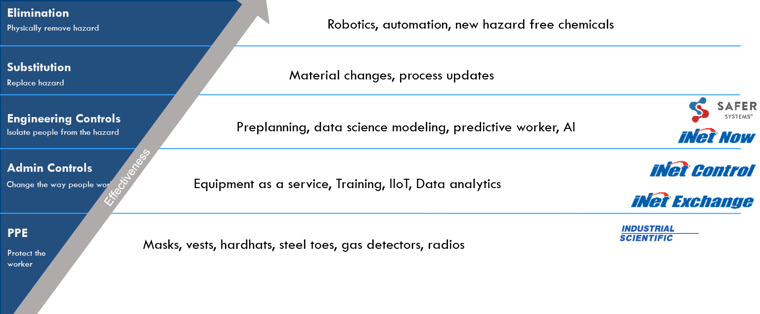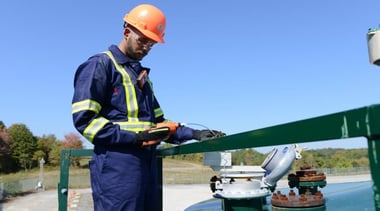When it comes to workplace safety, it is crucial to have plans in place. However, it's important to note that these plans may not always be foolproof. With constantly evolving factors, it's necessary to remain adaptable and ready to adjust in response to incidents. This is especially true in industrial settings that handle hazardous materials like toxic or explosive chemicals or gases, where mistakes can have serious consequences.
To ensure the safety of your team and your site, it's crucial to have access to scalable plans and the right information. This includes real-time weather updates, information on hazards and personnel locations, details on road closures and hot zones, and more, depending on your specific needs.
To be truly effective in responding to a chemical emergency, your safety team should regularly practice operational readiness principles. This not only prepares them for emergencies, but also helps to minimize risks during day-to-day procedures like turnarounds, planned releases, or odor complaints.
What is Operational Readiness?
Operational readiness is a state of being that requires careful planning, training, true-to-life drills, and coordination. Operational readiness should also involve your site’s community through community-wide drills.
Residents near chemical facilities rely on safety leaders and hazmat responders to instruct them on how to respond, what communication to expect, and training. Be sure to include your community in your operational readiness plans—they count on you to protect them.
The Benefits of Operational Readiness
Developing a state of operational readiness for hazmat response on your site can significantly reduce response times during emergencies or leaks, which can help protect the safety of your workers and community. Additionally, it can help prevent costly fines and disruptions in productivity.
According to US DOT, there were 28,829 hazmat incidents in 2022 alone. These incidents can end up costing your company around $209,249 a day if they cause property damage, bodily harm, or death. Given the frequency and high costs associated with hazmat incidents, you can see the importance of being prepared to respond and limiting the duration of exposure as much as possible.
Hierarchy of Safety Controls
Below is the hierarchy of safety controls and where Industrial Scientific’s solutions fit.

The most important thing to remember about this chart is that PPE only works when a hazard is already present! The key to worker safety is changing the way people work through engineering controls. A steel-toed boot is great, but it only works if something falls on your foot. In this example, a better approach is to train workers how to properly lift objects.
For chemical leaks, you can isolate people from hazards by using dynamic plume modeling software to plan for risky situations and establish procedures and drills to minimize exposure. This concept is essential to understanding the importance of operational readiness—if you depend only on personal gas detector sensors or other PPE to alert you to hazards, the atmospheric hazard has already reached workers (in other words, the heavy object has fallen on their feet).
Keys to Improving your Emergency Response
To improve your chemical emergency response, you should focus on three main areas: establishing effective communication channels, sharing real-time information, and conducting realistic drills in your facility and surrounding community.
These improvements allow you to gain clear visibility into your site's hazards before, after, and while they unfold. With the right information, your safety leaders and local responders can quickly resolve leaks to protect lives.
With all that said, let’s jump into the eight steps to establishing operational readiness for hazmat response.
Step 1: Establish Site Management
Site management ensures that the affected area during an incident is under control by determining who is likely to be impacted and either evacuating the area or restricting access as necessary to prevent injury.
You can accomplish this by running an emergency response guide (ERG) event to get a quick look into the worst-case scenario to see potential impact and critical evacuation areas.
Step 2: Identify Hazards
As information becomes available while an incident unfolds, like tank volume or chemical identification, dynamic plume models refine themselves to reflect the current situation. This is crucial, because making decisions based on out-of-date information can be a critical error. Dynamic plume modeling software like SAFER One® helps you understand information like isolation distance, how weather conditions affect the plume, and the worst-case scenario.
From all these details, SAFER One can identify the leak source and create a live plume which reveals where it’s been and where it will go with consistent updates as data evolves for the most accurate picture.
Step 3: Evaluate Risks and Hazards
With cloud-hosted software, you can easily share communications and updates with your hazmat responders to properly equip them to resolve the incident. You must continually evaluate the ongoing risks and potential further damage. By doing this effectively, you can deploy hazmat responders at a safe distance from potential explosions or high-risk areas.
Step 4: Select Protective Equipment and Connected Gas Detection
You can create a live, sensor-driven plume model without sending workers to danger zones by strategically placing area monitors around the hazard’s perimeter. Peer-to-peer connectivity like LENS wireless enables you to remotely monitor personal and area monitors so you can have confidence in hot zones locations and inform PPE selection for responders and your workers.
Connected safety makes it possible for you to gain visibility into your personnel and know their exposure status throughout the event.
Step 5: Coordinate Information
Establishing a common operating picture is crucial for chemical emergency response—that looks like live updates and the ability to host several users in one workspace to have a clear window into what’s happening on the ground. Hardware-agnostic software like SAFER One allows you to connect all your site’s gas detectors to achieve the largest safety impact.
Step 6: Adjust Response with Evolving Information
Dynamic plume models give you a two-hour window into the incident, allowing you to anticipate impacted areas and make real-time adjustments as the weather changes, which can happen rapidly. By pulling data from Google maps, you can pinpoint the exact locations of areas of concern. With easy access to changing conditions, you can continue to evolve your emergency response plan as you discover new information.
Community management is an essential part of this plan. By using details from your plume, you can communicate with dispatch and your community to evacuate or isolate areas of concern before the plume even reaches them.
Step 7: Decontaminate
It's essential to evaluate emergency response plans as new information is discovered. Sensor data can help track exposure to hazardous materials across your gas monitors. Plume modeling software also helps you understand the broader impact on your community.
For instance, if a school was exposed to gas, it's important to determine who was impacted and to what extent. You can see this by viewing a list of downwind areas and graphs of potential exposure, both indoors and outdoors. This knowledge enables you to take the necessary measures to decontaminate and ensure the safety of the community.
Step 8: Terminate Incident
Reporting and documentation are important responsibilities that you don’t want to deal with manually. SAFER One creates a single report that quantifies, justifies, and documents all the decisions you made during an incident. Historical data stored in your software makes it easier to investigate the incident afterwards and adjust your response plans moving forward to prevent similar events.
Conclusion
In the workplace, the more you can do to move up the hierarchy of safety controls, the better off your workers are because you’re removing as much of the risk as possible. Keeping your people safe with operational readiness is an investment that has major returns over time.
These tools aren’t just useful for emergencies! Chemical releases of all sizes happen daily. Make sure your workers, hazmat teams, and community can count on you to respond quickly and effectively to resolve them.
If you want to learn more about the steps to operational readiness for hazmat response and to see SAFER One in action, check out our on-demand webinar: Mastering the Critical First Hour: Operational Readiness for Hazmat Response.



